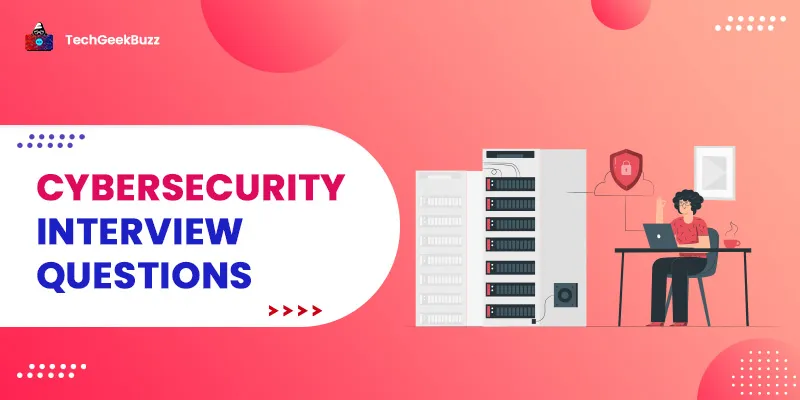Cybersecurity is the only area of information technology (IT) that has never experienced a downturn. The need for cybersecurity experts vastly outnumbers the availability, opening up exciting prospects for anyone willing to retrain for a profession in cybersecurity. But with increased demand comes more competitiveness, and to secure a job in cybersecurity, you have to be the best.
For this reason, we've compiled a list of the top cybersecurity interview questions and answers to help you master the interview.
Top 50+ Cybersecurity Interview Questions and Answers
We have divided the entire list of cybersecurity interview questions into three parts: Beginner, Intermediate, and Advanced.
Beginner-Level Cybersecurity Interview Questions
1. What do you understand about cybersecurity? What is its objective?
Cybersecurity is the process of preventing hostile electronic attacks on web systems such as hardware, software, programs, desktops, servers, handheld devices, networks, electronic devices, and data.
Computer security and IT security are other terms used to describe cyber security. The major objective of cyber security is to protect organizations and users against cyberattacks like acquiring, modifying, or losing crucial data.
2. What is cryptography?
Cryptography is a method or technique that is used to safeguard communication and information, primarily from third parties, known as adversaries. It's a means of encrypting data and communications so that only those who need to see it may read and interpret it.
We also examine numerous strategies for secure communication in cryptography, primarily to shield confidential data from third parties for whom the data was not intended.
3. What is the difference between a threat, vulnerability, and risk?
Threat:
- Any danger that has the capacity to destroy or steal information, impede operations, or inflict damage, in general, is considered to be a threat. It includes malware, phishing, data leaks, and even unethical staff.
- Groups or individuals with diverse backgrounds and goals, known as threat actors, make threats.
- Recognizing threats is critical for devising effective countermeasures and making intelligent cybersecurity decisions.
Vulnerability:
- A shortcoming in your electronics, software, hardware, or operations is referred to as a vulnerability.
- It's a gap that allows a threat actor to access your resources.
- The process of finding, disclosing, and resolving vulnerabilities is known as vulnerability management.
Risk:
- Risk is formed by combining the possibility of a threat and the effect of a vulnerability.
- It is the probability that a threat agent will succeed in exploiting a vulnerability, which can be computed using the following formula:
Risk = Likelihood of a threat * Vulnerability Impact
4. Explain the differences between SSL and TLS.
- SSL (Secure Socket Layer) is designed to confirm the sender's identity, but it doesn't look for anything else. SSL can assist you in tracking the person with whom you are conversing, but it can also be deceived sometimes.
- TLS (Transport Layer Security), like SSL, is an identification tool, but it has more security features. It adds another layer of security to the data, which is why SSL and TLS are frequently used together for enhanced security.
5. What is the difference between HIDS and NIDS?
Both HIDS (Host IDS) and NIDS (Network IDS) are intrusion detection systems that have the same goal of detecting intrusions. The only distinction is that HIDS is configured on a specific host or device. It keeps track of a device's traffic as well as unusual system activity. NIDS, on the other hand, is a networked system. It keeps track of the traffic of all network devices.
6. What is the distinction between IDS and IPS?
|
IDS |
IPS |
|
Intrusion detection system (IDS). |
Intrusion prevention system (IPS). |
|
IDS is only capable of detecting intrusions, not of preventing them. |
Intrusion detection and prevention are both possible with IPS. |
|
IDS is only a monitoring system. |
IPS is a control system. |
|
The results of IDS must be examined by a human or another system. |
IPS requires a database that is kept up to date with the most recent threat information. |
7. What is a traceroute? Why is it used?
A traceroute is used to illustrate the packet path by specifying all of the locations (mostly routers) through which the packet goes. When a packet does not reach its destination, the traceroute command is invoked. It can be used to determine where the connection breaks or stops, allowing us to pinpoint the source of the failure.
8. What is the difference between encryption and hashing?
|
Encryption |
Hashing |
|
To make temporary data transformations, encryption is utilized. |
Hashing is a method of permanently converting data into a message format. |
|
The encrypted data can be transformed back to the original data via the decryption procedure in encryption. |
The hashed data in hashing cannot be changed back to the original data. |
|
Encryption is used to keep critical information safe from third parties. |
Hashing is a technique for ensuring the integrity of data. |
9. What does a three-way handshake mean?
A three-way handshake is a technique for creating a connection between a host and a client in a TCP/IP network. The client-server exchanges packets in three steps, which is why it's called a three-way handshake. The following are the 3 steps:
- The client sends an SYN (synchronize) message to the server to see if it is up and running and if it has any open ports.
- If the server has open ports, it sends an SYN-ACK message to the client.
- The client acknowledges this and sends the server an ACK (acknowledgment) packet.
10. Define cognitive security?
Cognitive security is one of the AI applications that is specifically used for detecting risks and securing physical and digital systems using human comprehension procedures. To emulate the human brain, self-learning security systems use pattern recognition, natural language processing, and data mining.
11. How can you secure a server?
Secure servers use SSL (Secure Socket Layer) protocols for encrypting and decrypting data to keep it protected from unauthorized interception. Here's how you can secure your server:
Step 1 : Make sure your password is secure for both root and administrator users.
Step 2 : Make new users on your system to manage the complete system.
Step 3 : Remove the access from default accounts.
Step 4 : Configure the firewall rules for remote access.
12. What is data leakage?
Data leakage is the transmission of data (intentional or unintentional) from the organization to an external unauthorized destination. It is the leakage of confidential information on an unauthorized entity. Data leakage is divided into 3 categories:
- Intentional Breach : In this, the authorized source purposely sends the entity to the unauthorized source.
- Accidental Breach : In this, the entity sends data to an unauthorized source by mistake or a blunder.
- System Hack : In this, hacking techniques are used to crack the system and get confidential information.
13. What do you mean by brute force attack, and how can you protect it?
Brute force attack is a new way of identifying the right credentials by trying all the permutations and combinations of credentials.
Most of the time, brute force attacks are automatic attacks where the software/tool automatically identifies credentials. Some of the common ways to keep your data protected from this attack are as follows:
- Password Complexity : It includes different formats of characters, alphanumeric, special characteristics, and upper and lower case letters. Try them and increase the password complexity.
- Password Length : Set a minimum length for the password as the lengthy ones are hard to crack.
- Limiting Login Attempts : Set the limit of login attempts, which will restrict the user from being forced to enter the wrong password.
14. What is port scanning?
Port scanning is a technique used to identify the open ports and services available on the host. Hackers use port scanning to identify information that could help in identifying vulnerabilities. Here are the most common port scanning techniques:
- Ping scan
- TCP half-open
- TCP connect
- Stealth scanning
- UDP
15. What are the common layers in the OSI Model?
The OSI model is a reference model that shows how applications communicate on a network. The purpose of this model is to guide developers and vendors so that the digital communication products and other software programs can interoperate.
OSI comprises the following 7 layers:
- Application Layer : It provides an interface between the network and the application. The application layer provides a strong communication interface and focuses on process-to-process communication.
- Presentation Layer : This layer is all about presenting data in a particular format instead of showing it in the raw diagrams or packets.
- Session Layer : This controls the connection between the sender and receiver. This layer is responsible for sending, managing, and ending the session and maintaining the smooth interaction between the parties.
- Transport Layer : This is for making end-to-end communication; it splits the data and passes it to the network layer. Also, it ensures that the data has reached the other end successfully.
- Network Layer : This layer is for packet forwarding and providing the routing path for network communication.
- Datalink Layer : This handles the movement of data through a physical link; this link is also responsible for encoding and decoding the data bits.
- Physical Layer : This layer is responsible for transmitting digital data from the sender to the receiver.
16. What are the black hat, white hat, and gray hat hacking techniques?
Black Hat Hackers : A black hat hacker is known for breaking the computer network. They can write malware, which can be used to get into the system to hack it. These types of hackers misuse their skills to hack systems for malicious purposes.
White Hat Hackers : These are also called ethical hackers, who are mostly hired by companies to protect their systems. They are security specialists who keep an eye on security loops in the system and fix them.
Gray Hat Hackers : They are a combination of white and black.
17. What is the difference between symmetric encryption and asymmetric encryption?
|
Symmetric encryption |
Asymmetric encryption |
|
It takes only one key to do both encryption and decryption. |
It takes two keys to encrypt and decrypt. |
|
Encryption is fast. |
Encryption is slow. |
|
It uses few resources. |
It uses more resources. |
|
The ciphertext is the same size or smaller than the plain text. |
The ciphertext is the same size or greater than the plain text. |
|
AES and DES are examples of symmetric encryption. |
DSA and RSA are examples of asymmetric encryption. |
Intermediate-Level Cybersecurity Interview Questions
18. What do you mean by network sniffing?
Sniffing is a technique that is used for evaluating the data packets and is delivered across the network. Network sniffing is done by using special software or hardware; sniffing is used for:
- Listening on chat, messaging.
- Capturing confidential information.
- Keeps an eye on data packets.
19. What is a DNS attack?
DNS attack or Domain Name System attack is a type of cyberattack in which cyber criminals use weaknesses in the DNS to redirect users to unsafe websites and hack the data from the targeted machines. DNS attacks can be avoided by the following measures:
- Examining the DNS zones in the system.
- Ensuring that your DNS server is up to the mark.
- Hiding the BIND.
- Avoiding the DNS poisoning attempts.
- Using the DNS server that is separated.
- Using the DDOS migration service.
20. What is ARP poisoning?
Address resolution protocol (ARP) poisoning is a type of cyberattack that uses the network device to convert an IP address into a physical address. It is a practice of sending the fake address to the switch so that it can hack the IP address of the legitimate machine and hijack all the traffic.
21. What are polymorphic viruses?
Polymorphic viruses are those sophisticated file indicators that can clone themselves to avoid any detection. They attack the programming and put encryption keys every time to alter their physical file through every infection.
Also, these viruses use mutation engines to change the decryption routines every time they affect a machine. Since polymorphic viruses use complex mutation engines that generate millions of decryption routines, they are very difficult to detect.
22. What is the difference between vulnerability assessment and penetration testing?
Vulnerability assessment is the process of identifying flaws in the target. At this stage, the organization already knows that the system/network has weaknesses and wants to identify these flaws for fixing.
Penetration testing is the process of identifying vulnerabilities on the target. At this point, the organization has to set up the security measures they could think of and would want to check if there are other ways to identify if their network can be hacked.
23. What are the different types of response codes that can be received from a web application?
Following are the types of response codes that can be received:
- 1xx- Informational responses
- 2xx- Success
- 3xx- Redirection
- 4xx- Client-side error
- 5xx- Server-side error
24. How to set up a firewall?
To set a firewall, you need to:
- Change the default password for a firewall device.
- Disable the feature of remote administration.
- Configure port forwarding for some applications like web servers or FTP servers.
- Disable the DHCP firewall, as installing the firewall on the network with the existing DHCP server will cause conflicts.
- Enable logging; this will help troubleshoot firewall issues and other potential risks.
- Lastly, configure the firewall with security policies.
25. What are the common cyberattacks?
- Malware
- Password Attacks
- DDOS
- Man in the Middle
- Drive-By Downloads
- Malvertising
- Phishing
- Rogue Software
26. What do you mean by VPN?
VPN stands for Virtual Private Network; it is used to create a secure and encrypted connection for the data on the internet. By using a VPN, the data is sent from the client to the point in a VPN where it is encrypted; then, it is sent through the internet to another point where it is decrypted and sent to the server.
When the server sends the response, the response is sent to the point where it is encrypted, and the response is sent to the point where it is decrypted. The decrypted one is then sent to the client.
27. How can you prevent identity theft?
To prevent identity theft, here are some steps you can follow:
- Make passwords strong and unique.
- Do not share your confidential information online.
- Trust only authorized resources.
- Keep on updating your web browser.
- Install advanced malware tools.
- To secure financial data, use specialized security solutions.
- Update your system as well as the software.
- Protect the Social Security Number (SSN).
28. When should you perform patch management?
Patch management should be done instantly after it is released. For Windows as well as for the network devices, patch management should be done before the month.
29. What is CIA?
CIA stands for confidentiality, integrity, and availability; it's a model designed to create a security policy. This model consists of 3 concepts:
- Confidentiality ensures that the sensitive data should be accessed only by the authorized user.
- Integrity is all about using the information in the right format.
- Availability ensures that data and resources are available to the users who need them.
30. How to reset the password-protected BIOS configuration?
To protect the BIOS configuration, you must:
- Remove the CMOS battery.
- Use the software.
- Use a motherboard jumper.
- Use MS-DOS.
31. What is a MITM attack?
Man-in-the-Middle is a type of attack where the attacker hacks the communication happening between two points. The objective of such attacks is to access confidential and important information.
32. What do you mean by a botnet?
A botnet is a number of internet-connected devices like mobile devices, servers, IoT, and PCs that get infected by malware.
33. What do you mean by CSRF?
CSRF means Cross-site Request Forgery. It's malware that tricks the web browser into executing an unwanted action in the application to which the authenticated users have logged in.
The main objective of this attack is to get users' private data by making them log into an account that is controlled by the attacker.
34. What do you mean by 2FA, and how is it implemented on a public website?
TFA or 2FA, Two Factor Authentication, is a security process of adding another layer to the user's account before accessing it. In this, the user is granted access only after showing the authentication of the respective account.
35. What do you mean by XSS?
XSS is an acronym for Cross-Site Scripting. It's a web security attack in which the attacker uses malicious scripts in the code of the authentic application.
This attack occurs when the attacker uses a web application to send the hacking code through the browser's side script to another user.
36. What do you mean by WAF?
WAF is a Web Application Firewall that is used to protect the application by monitoring and filtering the incoming and outgoing traffic between the app and the web.
37. What is SSH?
SSH means Secure Socket Shell or also called Secure Shell. It's a utility suite that gives system administrators a secure way to access data on the network.
38. What do you mean by residual risk? How to deal with it?
Residual risk is a threat that helps balance the risk exposure after finding and eliminating the threat. You can reduce it, avoid it or accept it.
39. What is Exfiltration?
Exfiltration is all about transferring data from a system in an unauthorized manner. This transformation can be carried through someone who has manual access to the computer.
Advanced-Level Cybersecurity Interview Questions
40. Which protocol helps broadcast information across all devices?
IGMP, Internet Group Management Protocol, helps in broadcasting information. It's a communication protocol that is used in a game or video streaming. It comprises routers and other communication devices to send packets.
41. What is the difference between an RSA and Diffie-Hellman?
Diffie-Hellman is a protocol that is used in exchanging the key between two parties. RSA, on the other hand, is an algorithm that works on private and public keys.
42. What is Salting?
Salting is a process of extending the length of the passwords by adding unique random strings in the database or to every password before it gets hashed. The strings of the special characters that are added to the password are called salt; the salt can be added from the front or behind the password.
43. How does salting work?
When you create an account on an app or website, the password you use gets saved automatically for the next time. But, this password cannot be stored as a simple text, i.e., without any coding or formatting.
There should be some salt value in it before it gets hashed. For instance, if your password is mybook, then after adding the salt value (read%), it would become mybookread%. This salted password is then hashed and stored in the database.
44. What is the difference between encryption, hashing, and salting?
These three are security techniques that are used every day across various systems and websites. They are cryptographic terms needed for the security of passwords.
Here's how these terms are different from each other:
|
Encryption |
Hashing |
Salting |
|
Encryption is the form of cryptography where the data is encoded mathematically and can be accessed and decoded with the decryption key. Encryption is a two-way process; it can be reversed and read. It's a process of transforming secret information into a string of characteristics called a hash. |
In simple words, hashing is a process of scrambling information through an algorithm. It cannot be reversed; it's a one-way cryptographic function. It's like adding another layer of security to hashing. |
When the salt is added to the password, the hash gets changed. |
45. What do you mean by data exfiltration?
Data exfiltration means when unauthorized data is transferred from a computer system. This transmission can be manual or can be carried by someone who has physical access to the computer.
46. What do you mean by an exploit in network security?
Exploit is used by hackers to access the data in an unauthorized way; it is incorporated in the form of malware.
47. What is cross-site scripting?
Cross-site scripting is all about the network security issues in which the malicious scripts are inserted into the website. This attack occurs when the hackers allow a non-trusted source to insert code into a web application.
48. How do you protect email messages?
By using the cipher algorithm, you can protect credit card information, emails, and other corporate data.
49. What do you mean by remote desktop protocol?
RDP, a remote desktop protocol, is developed by Microsoft to provide a GUI to connect the two devices on a network.
50. What do you mean by forwarding secrecy?
Forward secrecy is a security measure that ensures the integrity of the unique session key at the time when the long-term key is compromised.
51. What is the difference between the stream cipher and block cipher?
|
Parameter |
Stream Cipher |
Block Cipher |
|
Working |
A stream cipher works on the plain test units. |
It works on large data blocks. |
|
Code requirement |
It needs less code. |
It needs more code. |
|
Key usage |
Key is used once. |
Key can be reused. |
|
Application |
SSL (Secure socket layer) |
File encryption and database. |
52. Show some examples of symmetric encryption algorithms.
Some of the common examples of symmetric encryption algorithms are as follows:
- Blowfish
- Rijndael
- DES
- RCx
53. What do you mean by ECB and CBC?
ECB is Electronic Codebook; it's the simplest form of operation. In this mode, the plain text messages are divided into sub-blocks at the sender site. Each cub-block is 64-bit and is encrypted independently.
CBC is Cipher Block Chaining; it works on block cipher encryption. This model ensures that if the block of plain text is repeated, it will generate the unique ciphertext for responding to the plain text blocks.
Like the ECB, plain messages are divided into sub-blocks of 64-bit each. The first and second blocks of the ciphertext are combined by using XOR and then encrypted by using a key.
At the other end, both the blocks are decrypted by using the same key, and the results are combined using XOR to generate plain text.
54. What is a buffer overflow attack?
A buffer overflow attack is an attack that takes advantage of the process to write more data of a fixed length of the memory block.
Conclusion
Cybersecurity is crucial because it protects all forms of data from being stolen or lost. Without a cybersecurity program, your firm will be unable to defend itself.
The knowledge of an action performed to secure a company's information assets is characterized as cyber security awareness.
When employees are cybersecurity aware, it means they are aware of all possible cyber threats , the potential consequences of them, and the measures to decrease risk and avoid cybercrime from infiltrating their online workspace.
People are also reading:





Leave a Comment on this Post